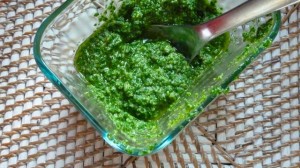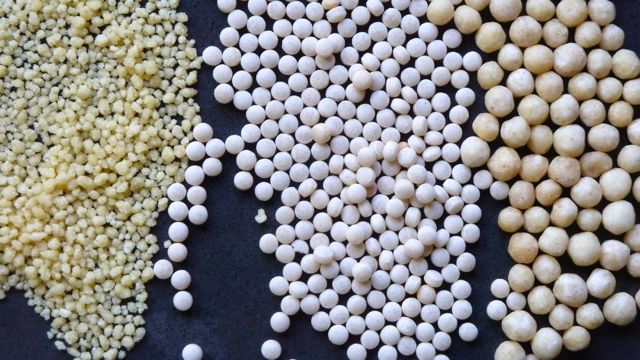Two salads might share a common basis, but the secret to what makes each distinct lies in the choice of sauce—and the mood it inspires. Could be scooped from a jar in haste or whirred in the food processor on a leisurely afternoon. Either way, we start with Israeli couscous, then let the stock pile of vegetables, and the dressing, steer the direction. If there’s time and herbs, we grind fresh pesto, then dollop the extras into freezer-ready containers, poised for future duty, when life is less leisurely. On a hectic night, we’re prone to yank a jar from the pantry—pepper-laced harissa perhaps, its kick of spice reflects the energy already bouncing around the room. Or perhaps the leftover pesto is a wiser choice, a dose of cooling cilantro might calm things down a notch or two. Either direction works—our destinations equally tasty, if entirely different.
Here’s the list of ingredients and the game plan.
It masquerades as a whole grain, but couscous is actually a pasta-like, semolina product that cooks up quickly and has a blank-slate aspect that happily embraces a wide range of sauces, fruits and vegetables. Flavor develops as you add things. In North Africa, the finished dish as well as the grains themselves are known as couscous, and North African couscous is what we typically find at the supermarket (pictured at left above) with grains about the size of coarse salt. Distant relatives like Israeli and Lebanese couscous (known in those countries as ptitim and moghrabieh) are larger versions with similar natures. You’ll find them stocked at specialty and high-end markets. The first might remind you of a ghostly lentil, blown up like a balloon (middle), the latter (pictured right) more pea sized. Because of their size, Israeli and Lebanese couscouses are particularly suited to salads—the dressing doesn’t weigh down these pearls as it might the finer, North African grains.
 On the sauce front, you’ve probably encountered pesto—the Italian paste ground from herbs or greens (often basil, but parsley, arugula, cilantro, even broccoli works), nuts or seeds, garlic, olive oil and often cheese. It’s easy to make, but a jar from the store is perfectly acceptable.
On the sauce front, you’ve probably encountered pesto—the Italian paste ground from herbs or greens (often basil, but parsley, arugula, cilantro, even broccoli works), nuts or seeds, garlic, olive oil and often cheese. It’s easy to make, but a jar from the store is perfectly acceptable.
 Think of harissa as pesto’s fiery North African cousin. It’s a mixture of oil, chili peppers, garlic and spices— sometimes with add-ins like tomato or parsley as well. Make some or grab a jar while you’re at Whole Foods.
Think of harissa as pesto’s fiery North African cousin. It’s a mixture of oil, chili peppers, garlic and spices— sometimes with add-ins like tomato or parsley as well. Make some or grab a jar while you’re at Whole Foods.
Either sauce offers our couscous a flavor jumpstart. We won’t need much more to get dinner moving.
Recipes for the Week:
- The first direction (click on links in blue for the recipes) that leaps to mind on a leisurely day (pictured at the top of the page) combines couscous with fresh cilantro pesto, carrots, green onions, radishes, snap peas and lightly steamed English peas. We’ll choose this salad for its healthy profile, bright herbal flavor and vibrant spring colors. Plus its loaded with the satisfying crunch of raw vegetables.
- The second (pictured below) takes advantage of veggies that roast while we fold a load of laundry (or put our feet up with a glass of wine), plus canned chickpeas, sautéed kale and harissa. While the first salad offers fiber and a nutritious range of vitamins, this one is pure comfort, smooth in texture and flavor—just what we need after a rough day. The undertones of bold harissa won’t go unnoticed, though, as they compliment the caramelized sweetness of the roasted vegetables.




